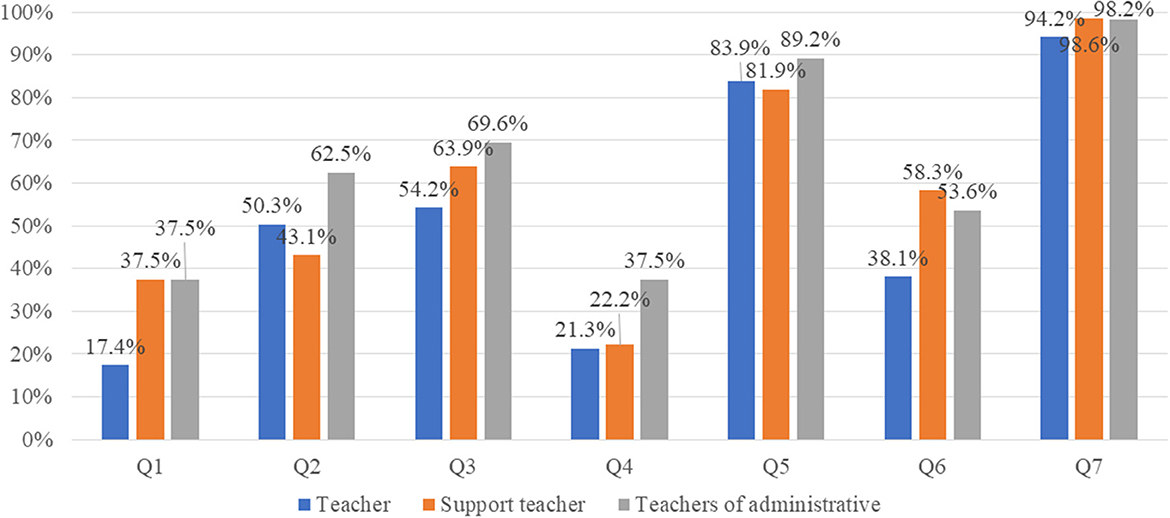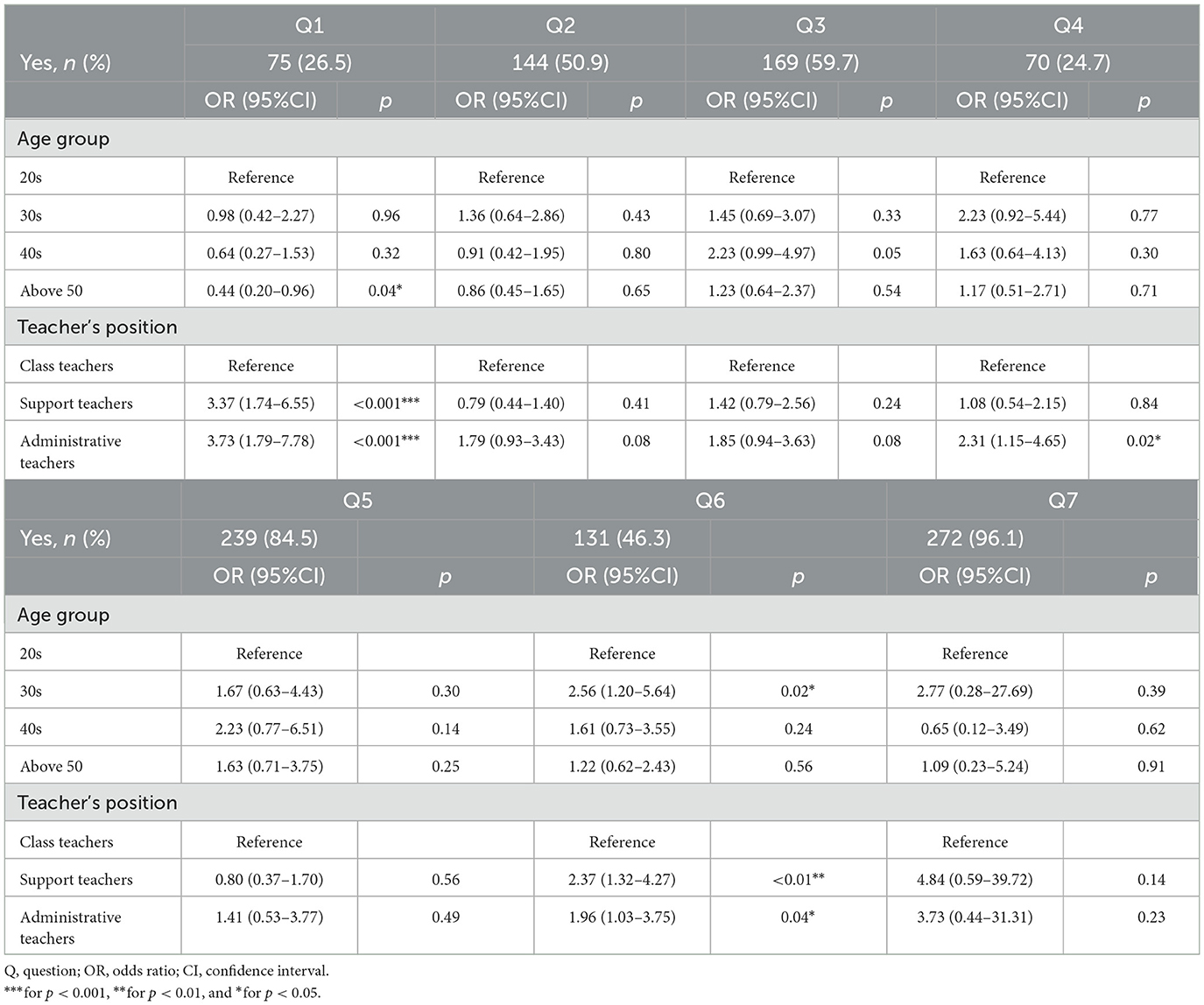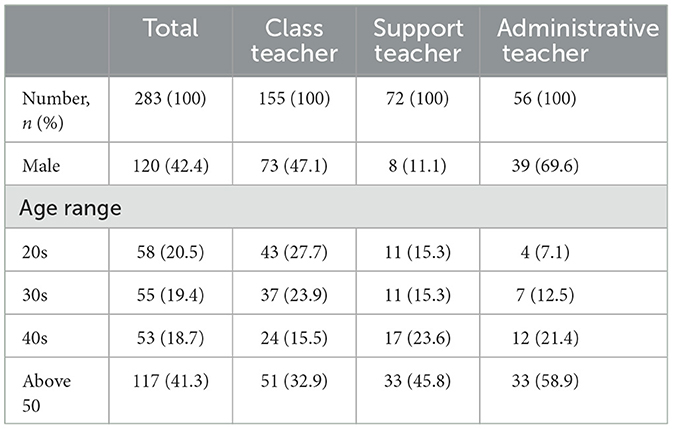- 1Department of Child Psychiatry, Ehime University Graduate School of Medicine, Toon, Japan
- 2Department of Neuropsychiatry, Ehime University Graduate School of Medicine, Toon, Japan
In recent years, concerns about internet addiction (IA) among children have been increasing. This study focused on the awareness of IA in elementary school teachers. A web-based anonymous survey was conducted in November 2021. The participants completed an original questionnaire about their awareness of IA. The participants were divided into three groups based on their positions in the classroom: class teachers, support teachers, and administrative teachers. Out of 283 participants, over 70% had not approached students with IA and had little practical knowledge about the disorder. Support and administrative teachers had more opportunities to interact with students with IA than class teachers (p < 0.001 in both cases). Support teachers had more opportunities to ask their colleagues about IA than class teachers (p < 0.01); similarly, administrative teachers also had more opportunities to discuss IA with colleagues than class teachers (p = 0.04). Preventive interventions are recommended for people who communicate with children with IA. Students with IA might cause anxiety among teachers; therefore, preventive education strategies should be implemented with the cooperation of psychiatrists, psychologists, and public health nurses.
1. Introduction
In Japan, almost all elementary, junior, and senior high schools have established a one-to-one computer–student ratio and developed a high-speed, large-capacity communication network. The information and communication technology (ICT) environment was accelerated as a countermeasure against the spread of COVID-19 from the end of 2020, and most of the abovementioned costs were subsidized by the Japanese government (1). The internet enables educational progress in schools, but internet addiction (IA) is a rising concern among the youth. The concept of IA is rooted in behavioral addiction and the addictive nature of various internet contents such as games, video clips, and social media (2). Excessive social media usage could be a risk factor for mental health problems, including depression, anxiety, and addiction (2). We previously reported a negative association between IA in adolescents and their sleep habits and mental states (3). According to a large-scale school-based study in an elementary school in Japan, IA and risky behaviors were common among children, and IA was associated with their own unhealthy lifestyles, including prolonged internet use, late bedtime, physical inactivity, and skipping breakfast as well as family and social environments, such as no rules at home and lack of close friends in real life and child–parent interactions (4). The negative effects of IA have been reported in children, such as elementary school students (5). Not only parents but also teachers are most likely to be an important source of social support for elementary school students (6). The quality of student–teacher relationships is a key factor that fosters or undermines students' school adjustment; for example, if the students perceive that their teachers support them and care about them, they will show better academic performance and fewer problem behaviors (7). Hence, supervision and guidance from parents and teachers are needed to help children develop good internet habits and minimize the negative effects of internet usage. However, to the best of our knowledge, no study has examined the awareness levels of teachers regarding IA and supervision, guidance, and preventive programs for students and their parents. Therefore, this study aimed to determine the awareness of IA using a survey targeting elementary school teachers.
2. Methods
A web-based anonymous survey was conducted in November 2021. The teachers at public elementary schools in Ehime Prefecture were included. Ehime Prefecture is located in western Japan and has a population of 1,326,000 and 8,000 in 2021. There were 290 public elementary schools in Ehime with about 66,000 students. The original questionnaire consisted of seven items, with yes/no responses:
1. Have you had the opportunity to interact with students with IA?
2. Have you ever been consulted by a parent?
3. Have you ever instructed individual students about using the internet?
4. Have you ever provided guidance to parents on their children's internet usage?
5. Do you have knowledge about IA?
6. Have you asked colleagues about IA?
7. Do you think education on preventing IA is necessary?
No consensus has been reached on the relevant criteria of addictive internet use. In this study, IA was defined as unspecified overuse of the internet using different applications (8). The survey was administered via the web, along with an explanation. The participants filled out an informed consent form online. The study was approved by the Institutional Review Board (IRB) of Ehime University Graduate School of Medicine (IRB No. 1809010). Categorical variables were expressed as numbers and percentages. The participants were divided into three groups based on the teachers' positions in the classroom: class teacher, support teacher (school nurse or teacher in special classes), and teachers in administrative positions, such as principal and vice principal. A binary logistic regression analysis was performed by dividing the teachers according to age and teaching position to determine the factors associated with each question. The P-values of < 0.05 (two-sided) were considered to be statistically significant. All statistical analyses were performed with SPSS Statistics 26.0 (IBM Corp., Armonk, NY, USA).
3. Results
Overall, 283 participants (120 male subjects and 163 female subjects) completed the survey. The most frequent respondents were class teachers (n = 155), followed by support teachers (n = 72) and administrative teachers (n = 56). Table 1 shows the characteristics of the participants in these three groups. Figure 1 shows the results of the questionnaire responses of the three groups. Regarding Q1, more than 70% of the teachers had not approached the students with IA, and only 17.4% of the teachers interacted with students who had IA. Table 2 shows the results of logistic regression analysis examining the factors associated with age group and teacher's position. Support teachers had more opportunities to interact with students with IA than class teachers [odds ratio (OR): 3.37, 95% confidence interval (CI): 1.74–6.55, p < 0.001]. Similarly, administrative teachers also had more opportunities to interact with students than class teachers (OR: 3.73, 95% CI: 1.79–7.78, p < 0.001). Teachers in their 50s had fewer opportunities to interact with students with IA than those in their 20s (OR: 0.44, 95% CI: 0.20–0.96, p = 0.04) (Q1). Administrative teachers had more opportunities to consult parents about their children's internet use than class teachers (OR: 2.31, 95% CI: 1.15–4.65, p = 0.02) (Q4). Support teachers had more opportunities to ask their colleagues about IA than class teachers (OR: 2.37, 95% CI: 1.32–4.27, p < 0.01); similarly, administrative teachers also had more opportunities to discuss IA with colleagues than class teachers (OR: 1.96, 95% CI: 1.03–3.75, p = 0.04). Teachers in their 30s had more opportunities to ask their colleagues about IA than those in their 20s (OR: 2.56, 95% CI: 1.20–5.64, p = 0.02) (Q6). Although there was no significant ratio difference among the three groups, more than 90% stated that education for preventing IA was needed (Q7).

Figure 1. Proportions of teachers who responded yes to each item. Values are expressed as percentages.

Table 2. Logistic regression analysis examining the factors associated with age group and teacher's position.
4. Discussion
This study aimed to examine teachers' attitudes toward students with IA. Our results showed that support and administrative teachers had more opportunities to interact with students and consult colleagues about IA; class teachers had fewer interactions with students with IA than support and administrative positions teachers. The age range coefficients are rarely significant and inconsistent, making the interpretation challenging.
Although the effect of IA on physiological and psychological health is tremendous, the prevalence is relatively low (4.2%) among elementary school students (4). However, a previous study reported an increase in screen time in the general population during the COVID-19 pandemic (9). In this study, only 17.4% of the class teachers had approached or interacted with students with IA. Although a simple comparison between current prevalence data and this survey may not be appropriate, the prevalence of IA among elementary school students may be higher than in the past report.
Although approximately half of the teachers were consulted by parents about IA (50.9%), many teachers were not able to offer advice to parents (24.7%) according to Q2 and Q4. IA was not categorized as a psychiatric disorder in the latest DSM or ICD; only gaming disorder is categorized as a psychiatric disorder according to the ICD-11. According to research on inclusive education, Japanese teachers have high anxiety levels. They are critical about including children with disabilities in their classrooms although many teachers believe inclusive education is necessary (10). Similarly, students with IA might also be a source of anxiety for teachers. Among typical occupations, teachers commonly report high levels of occupational stress (11). Class teachers, in particular, face multiple demands from students, parents, colleagues, and administrative teachers (12). Therefore, according to our results, support and administrative teachers can try to assist and advise class teachers, students, and parents facing problems related to internet usage.
Almost all participants stated that education for preventing IA was needed (Q7). Relatively brief school-based services seem to have positive effects on elementary-aged children; some programs go beyond the primary role of teachers (13). Hence, preventive education for IA should not be carried solely by school teachers, but the cooperation of related institutions and psychiatrists, psychologists, and public health nurses is needed. A research-based structured model using a widespread peer-support scheme, specially designed courses and seminars, testing for potential problems, and counseling services has been proposed to combat cyberbullying in Japan (14). Constructing a model that focuses not only on cyberbullying but also on IA may be beneficial. Although the literature on preventing IA is scarce, preventive interventions are recommended for people who communicate with children suffering from IA, such as parents, teachers, peers, and others close to them (15). However, there is insufficient information on the guidelines or general prevention methods in Japan. A recent study reported that a prevention program involving educational workshops would positively impact and help reduce children's susceptibility to IA (16). Specifically, peer-to-peer approaches, media literacy enhancement, reduction of co-morbid symptoms and negative psychosocial consequences, awareness-raising, and emphasis on positive psychology are effective prevention programs in school (17). In particular, school-based prevention programs for intermediate elementary students can help improve intermediate digital health literacy (18). Prevention programs in collaboration with school teachers should be implemented in future studies.
A methodological limitation of the study is that it was web-based; thus, only users with internet access could complete it. In addition, the survey was anonymous, where individual and school names were not revealed, so an accurate response rate could not be calculated. The relatively low participant number makes the results less generalizable and may not represent all teachers' opinions. Another limitation is that this study used a non-validated original questionnaire that limited the interpretability of the results and, therefore, the estimates and had a risk of bias.
Data availability statement
The original contributions presented in the study are included in the article/supplementary material, further inquiries can be directed to the corresponding author.
Ethics statement
The study was approved by the Institutional Review Board of Ehime University Graduate School of Medicine (IRB No. 1809010). Participants filled out the informed consent form online.
Author contributions
KK designed the study, performed the statistical analyses, analyzed and interpreted the data, drafted the manuscript, and prepared the first draft of the article. S-iU supervised this study. All authors contributed substantially to the analysis and interpretation of clinical data and contributed to and approved the final version of the manuscript.
Funding
The Japan Society financially supported this research for the Promotion of Science KAKENHI, Grant Number 20 K18935 (KK). The Department of Child Psychiatry at the Ehime University Graduate School of Medicine is supported by a grant from Ehime Prefecture, Japan.
Acknowledgments
This study was conducted in collaboration with the Ehime Prefecture Board of Education. The authors express gratitude to all the participants.
Conflict of interest
The authors declare that the research was conducted in the absence of any commercial or financial relationships that could be construed as a potential conflict of interest.
Publisher's note
All claims expressed in this article are solely those of the authors and do not necessarily represent those of their affiliated organizations, or those of the publisher, the editors and the reviewers. Any product that may be evaluated in this article, or claim that may be made by its manufacturer, is not guaranteed or endorsed by the publisher.
References
1. Kihara T. The light and shadow brought to teacher education by digitizing the educational environment: the case of Japan. Educ Sci. (2021) 11:399. doi: 10.3390/educsci11080399
2. Bozzola E, Spina G, Agostiniani R, Barni S, Russo R, Scarpato E, et al. The use of social media in children and adolescents: scoping review on the potential risks. Int J Environ Res Public Health. (2022) 19:9960. doi: 10.3390/ijerph19169960
3. Kawabe K, Horiuchi F, Oka Y, Ueno SI. Association between sleep habits and problems and internet addiction in adolescents. Psychiatry Investig. (2019) 16:581–7. doi: 10.30773/pi.2019.03.21.2
4. Yamada M, Sekine M, Tatsuse T, Asaka Y. Prevalence and associated factors of pathological internet use and online risky behaviors among Japanese elementary school children. J Epidemiol. (2021) 31:537–44. doi: 10.2188/jea.JE20200214
5. Sakamoto N, Kabaya K, Nakayama M. Sleep problems, sleep duration, and use of digital devices among primary school students in Japan. BMC Public Health. (2022) 22:1006. doi: 10.1186/s12889-022-13389-1
6. Zhang RP, Bai BY, Jiang S, Yang S, Zhou Q. Parenting styles and internet addiction in Chinese adolescents: conscientiousness as a mediator and teacher support as a moderator. Comput Hum Behav. (2009) 101:144–50. doi: 10.1016/j.chb.2019.07.019
7. Furrer CJ, Skinner EA, Pitzer JR. The influence of teacher and peer relationships on students' classroom engagement and everyday motivational resilience. In:Shernoff D, Bempechat J, , editors. NSSE Yearbook. Edition: Engaging Youth in Schools: Evidence-Based Models to Guide Future Innovations. New York, NY: Columbia University; Teachers College Record (2014). p. 101–23. doi: 10.1177/016146811411601319
8. Montag C, Wegmann E, Sariyska R, Demetrovics Z, Brand M. How to overcome taxonomical problems in the study of Internet use disorders and what to do with “smartphone addiction”? J Behav Addict. (2021) 9:908–14. doi: 10.1556/2006.8.2019.59
9. Alimoradi Z, Lotfi A, Lin CY, Griffiths MD, Pakpour AH. Estimation of behavioral addiction prevalence during COVID-19 pandemic: a systematic review and meta-analysis. Curr Addict Rep. (2022) 9:486–517. doi: 10.1007/s40429-022-00435-6
10. Yada A, Savolainen H. Japanese in-service teachers' attitudes toward inclusive education and self-efficacy for inclusive practices. Teach Teacher Educ. (2017) 64:222–9. doi: 10.1016/j.tate.2017.02.005
11. Hori D, Sasahara S, Oi Y, Doki S, Andrea CS, Takahashi T, et al. Relationships between insomnia, long working hours, and long commuting time among public school teachers in Japan: a nationwide cross-sectional diary study. Sleep Medicine. (2020) 75:62–72. doi: 10.1016/j.sleep.2019.09.017
12. Herman KC, Prewett SL, Eddy CL, Savala A, Reinke WM. Profiles of middle school teacher stress and coping: concurrent and prospective correlates. J Sch Psychol. (2020) 78:54–68. doi: 10.1016/j.jsp.2019.11.003
13. Sanchez AL, Cornacchio D, Poznanski B, Golik AM, Chou T, Comer JS. The effectiveness of school-based mental health services for elementary-aged children: a meta-analysis. J Am Acad Child Adolesc Psychiatry. (2018) 57:153–65. doi: 10.1016/j.jaac.2017.11.022
14. Kanayama K, Kurihara S. Preventive measures against cyberbullying at a university in Japan. In: Cyberbullying at University in International Contexts. London: Routledge (2018). p. 168–72. doi: 10.4324/9781315189406-14
15. Vondráčková P, Gabrhelík R. Prevention of internet addiction: a systematic review. J Behav Addict. (2016) 5:568–79. doi: 10.1556/2006.5.2016.085
16. Neverkovich SD, Bubnova IS, Kosarenko NN, Sakhieva RG, Sizova ZM, Zakharova VL, et al. Students' internet addiction: study and prevention. Eurasia J Math Sci Technol Educ. (2018) 14:1483–95. doi: 10.29333/ejmste/83723
17. Throuvala MA, Griffiths MD, Rennoldson M, Kuss DJ. School-based prevention for adolescent internet addiction: prevention is the key. A systematic literature review. Curr Neuropharmacol. (2019) 17:507–25. doi: 10.2174/1570159X16666180813153806
18. Hyman A, Stewart K, Jamin AM, Novak Lauscher H, Stacy E, Kasten G, et al. Testing a school-based program to promote digital health literacy and healthy lifestyle behaviours in intermediate elementary students: the learning for life program. Prev Med Rep. (2020) 19:101149. doi: 10.1016/j.pmedr.2020.101149
Keywords: internet addiction, elementary school, SNS, prevention, students, gaming disorder
Citation: Kawabe K, Horiuchi F, Hosokawa R, Nakachi K, Soga J and Ueno S-i (2023) School teachers' awareness of internet addiction in elementary school students: a regional survey in Japan. Front. Psychiatry 14:1187387. doi: 10.3389/fpsyt.2023.1187387
Received: 16 March 2023; Accepted: 21 June 2023;
Published: 13 July 2023.
Edited by:
Larisa Tatjiana McLoughlin, University of South Australia, AustraliaReviewed by:
Dai Miyawaki, Osaka City General Hospital, JapanLaura N. Smith, Texas A&M Health Science Center, United States
Vadim Kufenko, University of Hohenheim, Germany
Copyright © 2023 Kawabe, Horiuchi, Hosokawa, Nakachi, Soga and Ueno. This is an open-access article distributed under the terms of the Creative Commons Attribution License (CC BY). The use, distribution or reproduction in other forums is permitted, provided the original author(s) and the copyright owner(s) are credited and that the original publication in this journal is cited, in accordance with accepted academic practice. No use, distribution or reproduction is permitted which does not comply with these terms.
*Correspondence: Fumie Horiuchi, aG9yaXV0aS5mdW1pZS5jekBlaGltZS11LmFjLmpw
 Kentaro Kawabe
Kentaro Kawabe Fumie Horiuchi1*
Fumie Horiuchi1* Rie Hosokawa
Rie Hosokawa Shu-ichi Ueno
Shu-ichi Ueno